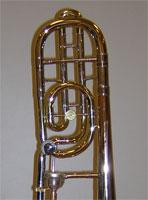 Most trombonists do a good job of taking care of their slides. From the very first day of band lessons we are trained on how to assemble the trombone safely as well as to properly oil and lubricate the main slide. For those that are advanced or lucky enough to have a trombone with an F-attachment there comes an additional maintenance task, that of caring the valve and it's additional tubing. Doing so is a relatively easy task, but one that is often overlooked in many student's daily rituals. When next putting together your trombone for the day consider these tips.
Most trombonists do a good job of taking care of their slides. From the very first day of band lessons we are trained on how to assemble the trombone safely as well as to properly oil and lubricate the main slide. For those that are advanced or lucky enough to have a trombone with an F-attachment there comes an additional maintenance task, that of caring the valve and it's additional tubing. Doing so is a relatively easy task, but one that is often overlooked in many student's daily rituals. When next putting together your trombone for the day consider these tips.
Also, for more direct information on trombone triggers and valves please read the brass and woodwinds workshop column of the October 2010 issue of Teaching Music Magazine.
Step 1- Oiling The Interior of the Trombone Trigger Valve
First of all, always check first with the manufacturer of the instrument to see what kind of oil and oiling technique they recommend. Doing a basic web search for something like Yamaha trombone valve oiling will often provide the user with specific directions for their instrument. In the absence of any specific instructions a generally good valve oiling method is stated below.
First, start with a good quality lightweight instrument oil. The thinner oil will have the advantage of helping to clean out the valve rotors. Be forewarned though that using too much oil will have the exact opposite effect, causing more dust and gunk to collect in the valve and causing problems down the road. Use only the minimal amount of oil necessary to accomplish the job.
Second, before assembling the trombone turn the bell section upside down and squeeze a fairly small amount into the joint while also holding the trigger half way down. Grady McGrannahan, Drake University Assistant Professor of Trombone suggests squeezing the bottle of oil while saying the words "oiling the valve," to get the proper amount of lubricant into the valve area then work the trigger several times to distribute the oil. Next, take a piece of paper towel or Kleenex and stuff it into the joint where the slide section connects, turn the bell back over, and allow the excess oil to drain back down onto the towel before pulling it out and finishing assembly of the instrument. You can also pull out the tuning slide that is associated with the valve and repeat the process oiling the valve from the top down.
For a visual reference to this type of oiling method take a look at the Yamaha Trombone Maintenance Manual.
Step 2- Oiling the Valve Spindles and Bearings
Oiling the trombone valve spindles and bearings is also very important but requires a different weight of oil. Be sure to use spindle oil or another oil as recommended by your manufacturer. Place a small drop of oil on the spindle where the trigger assembly attaches to the trombone. Usually there is a spring there as well. Oil each end of the spindle and then move on to the place where the trigger attaches to the valve itself. This spot will look different depending on the type of valve used on the horn, but an excellent video tutorial on the topic is available from Edwards Trombones.
 Step 3- Cleaning Up After Oiling The Trombone Valve
Step 3- Cleaning Up After Oiling The Trombone Valve
Once both the interior and exterior of the valve have been properly oiled allow the bell section to sit upright for a few minutes while you lubricate the main slide. When ready, pull the tissue paper out of the bell section and assemble the instrument as normal. Make sure that no excess oil is dripping down into the main slide section as oil mixing with slide cream or Slide-O-Mix is not a good thing.
Oiling the trombone trigger valve should be a regular part of every trombone player’s daily ritual, especially for advanced players that use the valve a lot. As always, taking care of your equipment properly will help it last longer and require fewer repairs over the long run.
Special thanks to Grady McGrannahan, Drake University Assistant Professor of Trombone, for his help and assistance with this article.
